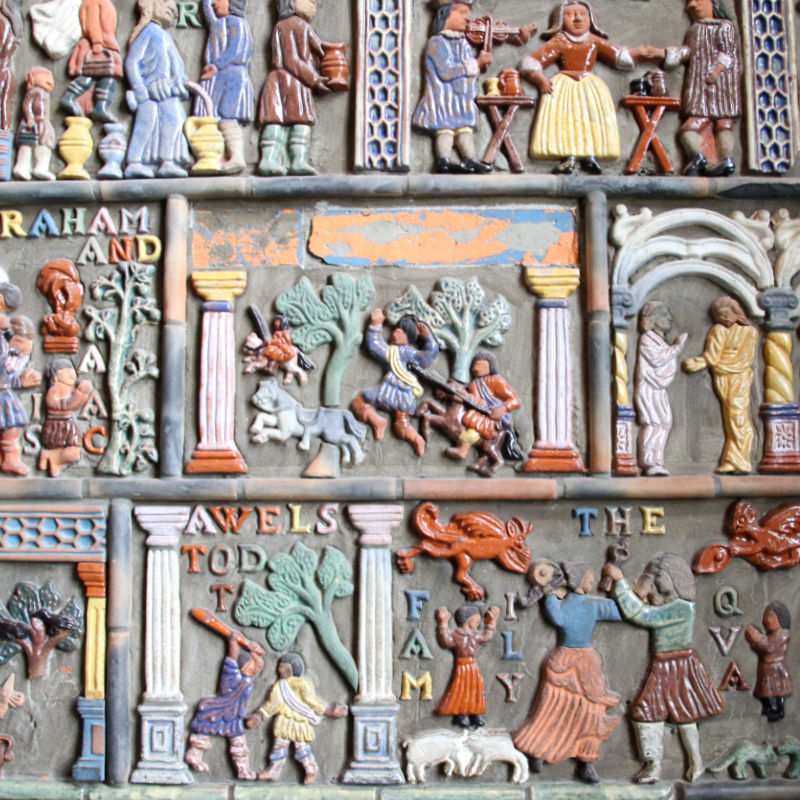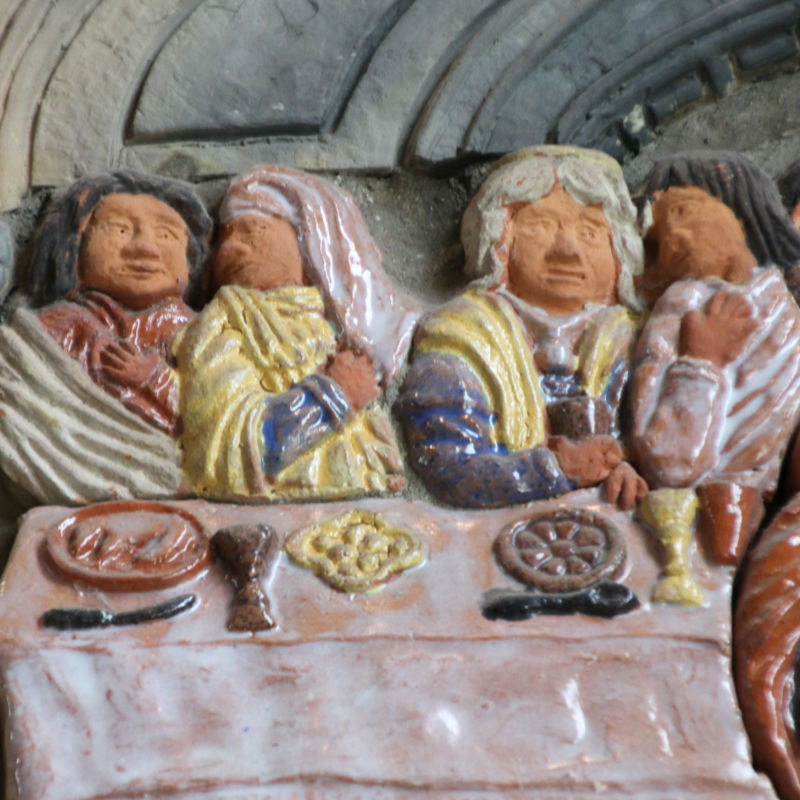Blog / 2014 / Fonthill Castle’s Questionable Copyright
July 3, 2014
Last month, I had the pleasure of visiting both the Mercer Museum and Fonthill Castle in Doylestown, Pennsylvania. These institutions are the creation of Henry Mercer, a wealthy eccentric working at the turn of the last century, and both are works of art, constructed out of poured concrete and a singular vision.

At the museum, Mercer’s enormous collection of ephemera is displayed, along with a number of Mercer’s tiles which were manufactured at his own tile works in Doylestown and which were based on designs he sketched out as he traveled around the world, avidly taking in the art of fifteen different cultures.

At the museum, I was welcome to take pictures, but the castle had a different policy. As soon as we arrived on the Fonthill property, the forbidding began. There were “no photography” signs everywhere. As a free culture advocate and one who encourages photography of her own art, I just had to know why.
My questioning began with our tour guide. He said that we couldn’t take pictures because of copyright. When I responded that since Mercer passed away in 1930 his copyright must have expired in 2000, the guide countered: “but not the government’s copyright!“
Since I didn’t want to ruin the visit for the other guests, I let that bizarre assertion go until the tour ended. As we were returning to the lobby, I asked the guide to explain the “government’s copyright,” but he deflected. He was only a volunteer and he suggested I speak with an employee, the receptionist.
She, at least, had the sense to admit that she didn’t know why photography was banned at the castle. When I asked her if I could speak with someone who did, she phoned the site administrator and took notes as he spoke to her. She then relayed to me that the rule existed for three reasons: “security, preservation, and timing.” She told me that I could sign up for a special photographer’s tour if I wanted. Instead, I struck up an email conversation with the site administrator.
Through that exchange, I learned that the photographer’s tour is a “workshop” that lasts four hours and costs $200.
I also discovered that:
- “SECURITY” means that they don’t want a potential thieves to case the joint with a camera. The thieves can, of course, still do their research, just not with documentation—unless they cough up the dough for the “workshop.”
- “PRESERVATION” is about how the flash from cameras could damage the ceramic tiles, the wood and metal fixtures, and the concrete along with the handful of original photos that have been left in the home. This, despite the fact that many of the books, records, and other archival materials have been moved to the museum for safe-keeping and replaced with dummies in the house.
- “TIMING” has to do with guests lagging behind to snap a good picture. I was more likely to see this as a valid issue in 2010 when I toured the working Kohler Factory. There, molten iron was a main feature and claw-foot tubs went flying through the air on their way to kilns.
But beyond these seemingly solvable logistical reasons, the site administrator also had other reasons for the rule:
“It is the moral and legal responsibility of the Historical Society and The Mercer Fonthill Trust to preserve and protect this national treasure for future generations.”
As part of that protection, the private nonprofit that maintains and operates the castle regulates when and where photography is allowed. He added:
“The contents and structures of Fonthill are considered the intellectual property of the Mercer Fonthill Trust. We view the visual aspects of the castle as a potential resource that we can use to raise additional monies to keep this special place open to the public and save it for future guests.”
This left me with still more questions, so I followed up by asking:
- How would amateur photographs be detrimental to the castle in your view?
- How did the transfer of copyright ownership between Henry Mercer and the Trust occur?
- Did Mercer form the Trust to allow for continued copyright control?
- When does the Trust’s copyright expire?
- How does all this match up with Mercer’s emphasis on pulling from other cultures and remixing these influences to make his own art?
Though the administrator had invited me to send him further questions, I got no more answers. In other words, the administrator and the tour guide were both relying on using the c-word and invoking the all-mighty IP to ward off any in-depth examination of the nonprofit’s policy.
They know that people are afraid of copyright law, because they themselves probably are. And they are counting on the fact that most people will assume that, if an institution doesn’t allow photography, it’s for good and legal reasons. The problem is that sometimes there aren’t good or legal reasons.
In this case, it seems clear to me that the Mercer Fonthill Trust is not honoring Henry Mercer’s work or protecting his legacy. The nonprofit has taken a work of art that was created by an artist who openly drew from other artists’s work, and it has removed that work from the cultural stew that nourishes future artists. This behavior isn’t logical, and it certainly isn’t the best way to cultivate creativity in the long run. Just think if Mercer himself had been told he couldn’t make sketches of artworks as he traveled. Would Fonthill Castle even exist today?
Did this post make you think of something you want to share with me? I’d love to hear from you!
To receive an email every time I publish a new article or video, sign up for my special mailing list.

